

Compact Muon Solenoid
LHC, CERN
| CMS-BPH-13-009 ; CERN-EP/2016-161 | ||
| Observation of the decay $\mathrm{B}^+ \to \psi( 2 \mathrm{S} ) \phi(1020) \mathrm{ K }^+$ in pp collisions at $\sqrt{s} = $ 8 TeV | ||
| CMS Collaboration | ||
| 10 July 2016 | ||
| Phys. Lett. B 764 (2017) 66 | ||
| Abstract: The decay $\mathrm{B}^+ \to \psi( 2 \mathrm{S} ) \phi(1020) \mathrm{ K }^+$ is observed for the first time using data collected from pp collisions at $\sqrt{s} = $ 8 TeV by the CMS experiment at the LHC, corresponding to an integrated luminosity of 19.6 fb$^{-1}$. The branching fraction of this decay is measured, using the mode $\mathrm{B}^+\to \psi( 2 \mathrm{S} ) \mathrm{ K }^+$ as normalization, to be ( 4.0 $\pm$ 0.4 (stat) $\pm$ 0.6 (syst) $\pm$ 0.2 ($\mathcal{B})$ )$\times$ 10$^{-6}$, where the third uncertainty is from the imprecision in the normalization channel. | ||
| Links: e-print arXiv:1607.02638 [hep-ex] (PDF) ; CDS record ; inSPIRE record ; CADI line (restricted) ; | ||
| Figures | |
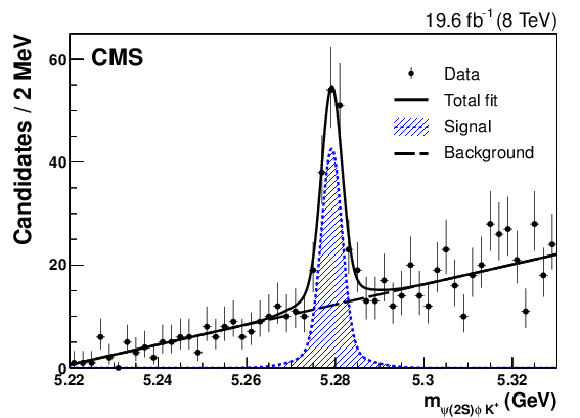
png pdf |
Figure 1:
The $\psi( 2 \mathrm{S} ) \phi \mathrm{ K }^+ $ mass distribution after the selection requirements. The solid curve shows the result of fitting this distribution to a signal represented by two Gaussian functions and a first-order polynomial for the background. The shaded area represents the signal component, while the dotted line shows the fitted background contribution. |

png pdf |
Figure 2:
The distributions of the $\mathrm{ K }^+ \mathrm{ K }^- $ invariant mass closest to the nominal $\phi $ mass within (a) and outside (b) the $\mathrm{B}^+ $ mass window. The results show the total fit, as well as the four components: $\phi $ signal, non-$\mathrm{B}^+ $ background, non-$\phi $ signal, and in (b) the Crystal Ball function component of the non-$\mathrm{B}^+ $ background. |

png pdf |
Figure 2-a:
The distributions of the $\mathrm{ K }^+ \mathrm{ K }^- $ invariant mass closest to the nominal $\phi $ mass within (a) and outside (b) the $\mathrm{B}^+ $ mass window. The results show the total fit, as well as the four components: $\phi $ signal, non-$\mathrm{B}^+ $ background, non-$\phi $ signal, and in (b) the Crystal Ball function component of the non-$\mathrm{B}^+ $ background. |
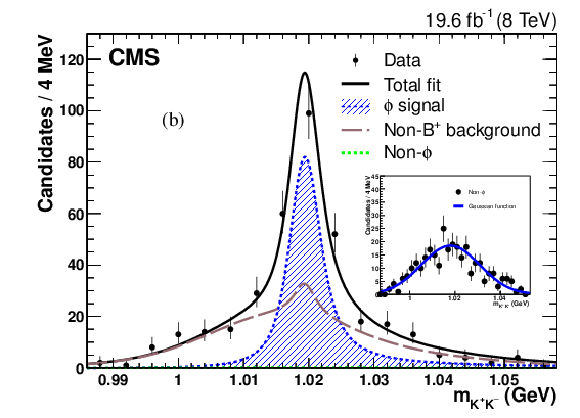
png pdf |
Figure 2-b:
The distributions of the $\mathrm{ K }^+ \mathrm{ K }^- $ invariant mass closest to the nominal $\phi $ mass within (a) and outside (b) the $\mathrm{B}^+ $ mass window. The results show the total fit, as well as the four components: $\phi $ signal, non-$\mathrm{B}^+ $ background, non-$\phi $ signal, and in (b) the Crystal Ball function component of the non-$\mathrm{B}^+ $ background. |
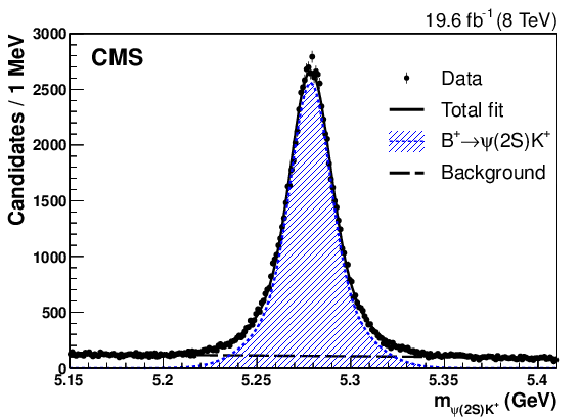
png pdf |
Figure 3:
The $\psi( 2 \mathrm{S} ) \mathrm{ K }^+ $ invariant mass distribution after implementing all the event selection requirements. The solid curve shows the result of fitting this distribution to a signal corresponding to two Gaussian functions and a first-order polynomial for the background. The shaded area represents the contribution from the $\mathrm{B}^+ \to \psi( 2 \mathrm{S} )\mathrm{ K }^+ $ channel, while the dotted line shows the fitted background contribution. |
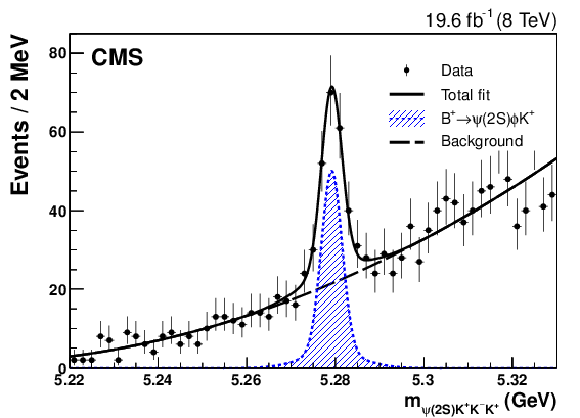
png pdf |
Figure 4:
The $\psi( 2 \mathrm{S} ) \mathrm{ K }^+ \mathrm{ K }^- \mathrm{ K }^+ $ invariant mass distribution with no $\phi $ mass selection. The solid curve shows the result of fitting this distribution to a signal represented by two Gaussian functions and a second-order polynomial for the background. The shaded area represents the signal component, while the dotted line shows the fitted background contribution. |
| Tables | |

png pdf |
Table 1:
The selection criteria derived from the optimization procedure. |
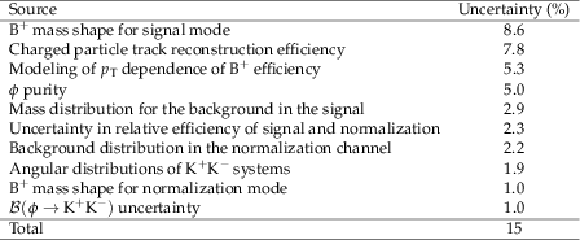
png pdf |
Table 2:
Relative systematic uncertainties in the measurement of $\mathcal {B}(\mathrm{B}^+ \to \psi( 2 \mathrm{S} ) \phi \mathrm{ K }^+ )$ in percent. The total systematic uncertainty corresponds to the sum in quadrature of the listed uncertainties. |
| Summary |
| In summary, the $\mathrm{B}^+\to \psi( 2 \mathrm{S} )\phi \mathrm{ K }^+$ decay has been observed for the first time by the CMS Collaboration. The result has been achieved using data from pp collisions at $\sqrt{s} =$ 8 TeV, corresponding to an integrated luminosity of 19.6 fb$^{-1}$. The branching fraction $\mathcal{B}(\mathrm{B}^+\to \psi( 2 \mathrm{S} )\phi\mathrm{ K }^+)$ is determined to be (4.0 $\pm$ 0.4 (stat) $\pm$ 0.6 (syst) $\pm$ 0.2 ($\mathcal{B}$))$\times$ 10$^{-6}$, where the third uncertainty reflects the imprecision in the value of $\mathcal{B}(\mathrm{B}^+\to \psi( 2 \mathrm{S} )\mathrm{ K }^+)$. The upper limit on the fraction of $\mathrm{B}^+\to \psi( 2 \mathrm{S} ) (\text{non-}\phi)\mathrm{ K }^+$ decays in $\mathrm{B}^+ \to \psi( 2 \mathrm{S} ) \mathrm{ K }^+\mathrm{ K }^+\mathrm{ K }^+$ channel is found to be 0.26 at 95% confidence. The observation of $\mathrm{B}^+\to \psi( 2 \mathrm{S} )\phi \mathrm{ K }^+$ offers future opportunities in searches for resonances in the $\psi( 2 \mathrm{S} )\phi$ mass spectrum. |
| References | ||||
| 1 | CDF Collaboration | Evidence for a Narrow Near-Threshold Structure in the $ \mathrm{J}/\psi\phi $ Mass Spectrum in $ B^+\to \mathrm{J}/\psi\phi K^+ $ Decays | PRL 102 (2009) 242002 | 0903.2229 |
| 2 | LHCb Collaboration | Search for the $ X(4140) $ state in $ B^+ \to \mathrm{J}/\psi \phi K^+ $ decays | PRD 85 (2012) 091103 | 1202.5087 |
| 3 | D0 Collaboration | Search for the X(4140) state in $ B^{+}\rightarrow \mathrm{J}/\psi \phi K^+ $ decays with the D0 detector | PRD 89 (2014) 012004 | 1309.6580 |
| 4 | CMS Collaboration | Observation of a peaking structure in the $ \mathrm{J}/\psi \phi $ mass spectrum from $ B^{\pm} \to \mathrm{J}/\psi \phi K^{\pm} $ decays | PLB 734 (2014) 261 | CMS-BPH-11-026 1309.6920 |
| 5 | BaBar Collaboration | Study of $ B^{\pm,0} \to \mathrm{J}/\psi K^+ K^- K^{\pm,0} $ and search for $ B^0 \to \mathrm{J}/\psi\phi $ at BaBar | PRD 91 (2015) 012003 | 1407.7244 |
| 6 | LHCb Collaboration | Observation of $ \mathrm{J}/\psi\phi $ structures consistent with exotic states from amplitude analysis of $ B^+\to\mathrm{J}/\psi \phi K^+ $ decays | 1606.07895 | |
| 7 | LHCb Collaboration | Amplitude analysis of $ B^+\to \mathrm{J}/\psi \phi K^+ $ decays | 1606.07898 | |
| 8 | CMS Collaboration | Description and performance of track and primary-vertex reconstruction with the CMS tracker | JINST 9 (2014) P10009 | CMS-TRK-11-001 1405.6569 |
| 9 | CMS Collaboration | The CMS experiment at the CERN LHC | JINST 3 (2008) S08004 | CMS-00-001 |
| 10 | T. Sjostrand, S. Mrenna, and P. Skands | PYTHIA 6.4 physics and manual | JHEP 05 (2006) 026 | hep-ph/0603175 |
| 11 | D. J. Lange | The EvtGen particle decay simulation package | NIMA 462 (2001) 152 | |
| 12 | GEANT4 Collaboration | GEANT4: A simulation toolkit | NIMA 506 (2003) 250 | |
| 13 | Particle Data Group, K. A. Olive et al. | Review of Particle Physics | CPC 38 (2014) 090001 | |
| 14 | CMS Collaboration | CMS tracking performance results from early LHC operation | EPJC 70 (2010) 1165 | CMS-TRK-10-001 1007.1988 |
| 15 | G. Punzi | Sensitivity of searches for new signals and its optimization | in Proceedings of PHYSTAT 2003, Statistical problems in particle physics, astrophysics and cosmology, L. Lyons, R. P. Mount, and R. Reitmeyer, eds Stanford, USA | physics/0308063 |
| 16 | W. Verkerke and D. P. Kirkby | The RooFit toolkit for data modeling | in Proceedings of PHYSTAT 05: Statistical problems in particle physics, astrophysics and cosmology, L. Lyons and M. Karagoz, eds Oxford, 2005 | physics/0306116 |
| 17 | S. M.Flatt\'e et al. | Analysis of the observed anomaly in $ \pi\pi $ s-wave scattering near $ \mathrm{K \bar{K}} $ threshold | PLB 38 (1972) 232 | |
| 18 | M. J. Oreglia | A study of the reactions $\psi' \to \gamma\gamma \psi$ | PhD thesis, Stanford University, 1980 SLAC Report SLAC-R-236, see Appendix D | |
| 19 | T. Junk | Confidence level computation for combining searches with small statistics | NIMA 434 (1999) 435 | hep-ex/9902006 |
| 20 | A. L. Read | Presentation of search results: the $ \it{CL}_{s} $ technique | JPG 28 (2002) 2693 | |
| 21 | G. Cowan, K. Cranmer, E. Gross, and O. Vitells | Asymptotic formulae for likelihood-based tests of new physics | EPJC 71 (2011) 1554 | 1007.1727 |

|
Compact Muon Solenoid LHC, CERN |

|

|

|

|

|

|